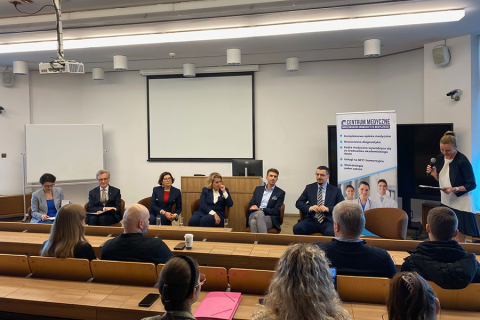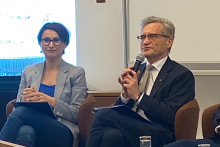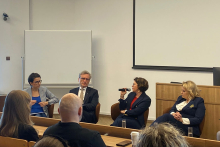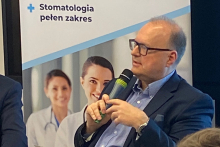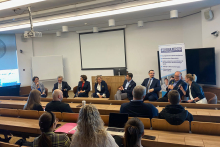There are 3.5 million diabetics in Poland. There are about 2,150,000 people with type II diabetes, and about 180,000 with type I diabetes. Unfortunately, there are still many people with type 2 diabetes who are not aware of the disease, and therefore do not implement treatment that would prevent the development of the disease and its complications. According to forecasts, if the dynamics of the incidence continues at the current level, in 2030 the number of Poles affected by the disease will rise to 4.2 million. Participants in the debate - medical experts - discussed how to fight diabetes and how to increase awareness of the disease in society.
- Education is the foundation and should start as early as the preschool stage, as the education at home does not always work in this regard. Due to the number of undiagnosed people, I am in favor of making diabetes detection tests mandatory in the catalog of occupational medicine tests - said Senator Agnieszka Gorgoń-Komor, MD, PhD, cardiologist and internal medicine specialist.
According to her, well-controlled diabetes, early detection and prevention, reduce the risk of organ changes, e.g. in the heart, kidneys, which translates into a better prognosis of the disease and the quality and length of the patient's life.
The senator stressed that prediabetes can be predicted with very high probability.
- If both parents had diabetes, there is almost a one hundred percent chance that we too will get the disease. Therefore, the most important thing is preventive action, not just pharmacological. That is, a good diet, physical activity, fighting obesity - explained Agnieszka Gorgoń-Komor, MD, PhD.
Obesity and lack of exercise as key factors in type II diabetes were pointed out by all participants in the debate. They stressed that in Poland we have an obesity epidemic - almost 60 percent of the population is overweight.
According to Prof. Zbigniew Gaciong, Rector of MUW, the problem of obesity cannot be straightforwardly solved with weight-loss preparations alone. He cited a study assessing the physical fitness of elementary school children, which found that in a study group of 25,000 children, only 6 percent were able to perform simple exercises (e.g., jumping jacks, forward flips).
- The epidemic of issuing medical certificates of inability to physical effort is unfortunately widespread. It can be predicted that these children will not engage in sports in the future. And this can translate into worsening problems with maintaining a healthy body weight, the onset of overweight and then obesity. And this is a straight road to type 2 diabetes - said Prof. Zbigniew Gaciong.
According to the Rector of MUW, the problem of diabetes today goes beyond medicine, so in addition to doctors, politicians should also address it, for example by stimulating educational activities and fiscal policy.
- The purpose of introducing a sugar tax in Poland was to subsidize diabetes research, a method that can be used to fight the disease. Unfortunately, we do not know how these funds are being used - concluded Prof. Zbigniew Gaciong.
The problem of inadequate nutrition was brought to the attention by Prof. Leszek Czupryniak, Head of the Department of Diabetology and Internal Medicine MUW.
- Food culture has gone in the wrong direction. Building a cult of food, for example, through culinary programs, causes us to assign too great a role to food: that it is so important, that it serves to build relationships. Meanwhile, the joy of life can also be derived from other areas of activity, from other things - stressed Prof. Leszek Czupryniak.
He added that in the fight against diabetes, for several years we have had systems that inform the patient continuously about blood sugar levels. This allows the patient to learn how individual meals affect blood glucose levels and modify the diet accordingly so that diabetes is effectively controlled.
- Thanks to the fact that we are using modern glycemic monitoring systems more and more widely, we have seen that every patient with diabetes benefits from their use. Access to them is expanding, and I hope it will continue to expand, because modern glycemic monitoring systems are a powerful educational tool, including for newly diagnosed patients - said Prof. Leszek Czupryniak.
The debate "How to stop the diabetes epidemic?" organized by the Medical University of Warsaw was attended by:
- Senator Agnieszka Gorgoń-Komor, MD, PhD, a cardiologist and internal medicine specialist
- Prof. Zbigniew Gaciong, MD, PhD, His Magnificence the Rector of MUW
- Prof. dr hab. n. med. Leszek Czupryniak, kierownik Kliniki Diabetologii i Chorób Wewnętrznych WUM
- Prof. Leszek Czupryniak, MD, PhD, Head of the Department of Diabetology and Internal Medicine MUW
- Anna Jeznach-Steinhagen, MD, PhD, diabetologist, Department of Clinical Dietetics MUW
- Dr n. o zdr. Grzegorz Juszczyk, Zakład Zdrowia Publicznego WUM
- Grzegorz Juszczyk, DHSc, Department of Public Health MUW
- Filip Raciborski, MD, PhD, specialist in public health MUW
The debate was moderated by: Justyna Mieszalska, President of the Medical Center MUW, and Małgorzata Perl, MA, President of the Exercise is Medicine Foundation.
Diabetes is a disease characterized by excessively high blood glucose levels, which leads to the development of serious chronic complications, deterioration of the patient's health and quality of life, and, if uncontrolled, a significantly shortened life span. In order to prevent this, it is necessary to maintain normal blood sugar levels, and this is possible through regular daily repeated glucose measurements throughout the day.
More than 90% of patients with diabetes are type 2 diabetics. Treatment of type 2 diabetes varies at different stages, as different medications are used at the beginning of the disease and others at an advanced stage when complications arise. On the other hand, what is important is to always try to keep sugar fairly stable and close to normal. This is a challenge because sugar levels are not influenced only by medications, but mainly by what the patient eats and what physical activity he or she pursues. For several years we have had systems that tell the patient continuously what his blood sugar level is. This is done by means of a sensor placed to the back of the patient's arm, which sends information to the phone via an app, so the patient has a continuous view of his blood glucose. Continuous glycemic monitoring systems are educational tools, because people with diabetes, through continuous observation of their blood glucose, can draw conclusions about what foods serve them, whether there is a need for a higher dose of insulin at any given time, or whether physical activity should be increased. And glycemic monitoring is becoming simple, safe and painless thanks to modern technology.
